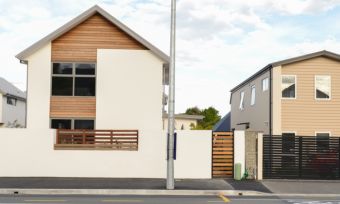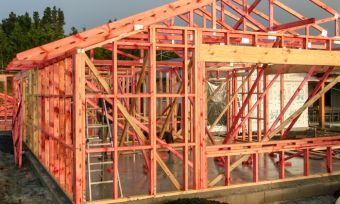To buy or to build – it’s a simple question, for sure. But, unfortunately, the answer is a little more complicated. So Canstar decided to delve a little deeper into the question and crunch the numbers to discover whether it’s cheaper to buy an existing home in New Zealand or to build a new one.
Cheaper to buy or build? It’s all about the land!
A couple of years ago in one of its Financial Stability Reports, the Reserve Bank noted that land accounts for around 60% of the value of a Kiwi home. So as a starting point for our Build vs Buy number crunching, let’s break down the median house prices around the country into two components:
- Cost of Land (60%)
- Cost of Home (40%)
Cheaper to buy or build? Cost of an existing home
Based on current median house prices from REINZ, if you break down the cost of an existing home into its two components, it looks like this:
| Region | Median Price June 2024 |
Cost of Land 60% |
Cost of House 40% |
| Auckland | $1,048,000 | $628,800 | $419,200 |
| Bay of Plenty | $780,000 | $468,000 | $312,000 |
| Wellington | $780,000 | $468,000 | $312,000 |
| Tasman | $777,000 | $466,200 | $310,800 |
| Waikato | $720,000 | $432,000 | $288,000 |
| Canterbury | $690,000 | $414,000 | $276,000 |
| Hawke’s Bay | $662,500 | $397,500 | $265,000 |
| Nelson | $650,000 | $390,000 | $260,000 |
| Taranaki | $631,000 | $378,600 | $252,400 |
| Northland | $630,000 | $378,000 | $252,000 |
| Otago | $625,000 | $375,000 | $250,000 |
| Marlborough | $620,000 | $372,000 | $248,000 |
| Gisborne | $615,000 | $369,000 | $246,000 |
| Manawatu-Whanganui | $535,000 | $321,000 | $214,000 |
| Southland | $440,000 | $264,000 | $176,000 |
| West Coast | $320,000 | $192,000 | $128,000 |
Cheaper to buy or build? Cost of a new build in NZ
Now we have an idea of land values, it’s time to factor in building costs.
On the Canstar website, our story How Much to Build a New House in NZ is one of the most popular reads. It reveals the average cost of new builds across the county based on building consent applications.
By using these building consent figures, and the land prices listed above, we can work out a rough estimation of how much it costs to buy a piece of land and build a new house in different regions around the country:
| Region | Land Cost | Cost of New Build | New Build + Land |
| Auckland | $628,800 | $475,530 | $1,104,330 |
| Tasman | $466,200 | $590,742 | $1,056,942 |
| Otago | $375,000 | $600,561 | $975,561 |
| Nelson | $390,000 | $549,147 | $939,147 |
| Bay of Plenty | $468,000 | $470,270 | $938,270 |
| Taranaki | $378,600 | $540,418 | $919,018 |
| Wellington | $468,000 | $437,105 | $905,105 |
| Waikato | $432,000 | $462,867 | $894,867 |
| Hawke’s Bay | $397,500 | $465,838 | $863,338 |
| Canterbury | $414,000 | $414,310 | $828,310 |
| Northland | $378,000 | $434,975 | $812,975 |
| Marlborough | $372,000 | $380,001 | $752,001 |
| Gisborne | $369,000 | $371,600 | $740,600 |
| Manawatu-Whanganui | $321,000 | $414,091 | $735,091 |
| Southland | $264,000 | $464,642 | $728,642 |
| West Coast | $192,000 | $355,958 | $547,958 |
Cheaper to buy or build? Old vs new
When the price of land is factored into the cost of a new build, they work out more expensive (on average around a third more expensive) than existing median-priced homes in the same areas:
| Region | Median House Price June 2024 |
Cost of New Build + Land |
% Difference |
| Auckland | $1,048,000 | $1,104,330 | 5% |
| Bay of Plenty | $780,000 | $938,270 | 20% |
| Wellington | $780,000 | $905,105 | 16% |
| Tasman | $777,000 | $1,056,942 | 36% |
| Waikato | $720,000 | $894,867 | 24% |
| Canterbury | $690,000 | $828,310 | 20% |
| Hawke’s Bay | $662,500 | $863,338 | 30% |
| Nelson | $650,000 | $939,147 | 44% |
| Taranaki | $631,000 | $919,018 | 46% |
| Northland | $630,000 | $812,975 | 29% |
| Otago | $625,000 | $975,561 | 56% |
| Marlborough | $620,000 | $752,001 | 21% |
| Gisborne | $615,000 | $740,600 | 20% |
| Manawatu-Whanganui | $535,000 | $735,091 | 37% |
| Southland | $440,000 | $728,642 | 66% |
| West Coast | $320,000 | $547,958 | 71% |
Cheaper to buy or build? New is expensive!
That new builds are no cheaper than existing homes should not be a surprise. New things are generally more expensive than second-hand items. And even a basic new build is going to be worth a lot more than an unrenovated older home.
With average building costs now around $3500 per m2, a 142m2 Kiwi home (the average size built last year) is going to cost close to $500,000 to build. Then you need to add the cost of the land, which will be a further $400-$500k in most areas.
However, there are things you can do to keep building costs down:
- Buy land in cheaper new greenfield developments, outside of more expensive inner-city suburbs
- Build a smaller home
- Avoid elevated sites, exposed to the wind
- If possible buy a flat level site, avoid steep (or even not so steep) sites that require retaining walls
- Avoid unsuitable ground requiring engineering design, or places with difficult site access
- Don’t use large square metres of glass (requiring steel portals)
- Have smaller rooms, not open, expansive living areas that requiring engineering due to the lack of walls to brace
- Avoid cantilevered decks, roofs and floors
- Don’t use expensive cladding, like cedar, or roofing, such as tray roofing
- Say no to any build methods that are time consuming
→ Related article: Lowest Construction Loan Interest Rate Deals
Cheaper to buy or build: The best construction loans
Ultimately, one of the easiest ways to reduce the cost of building or buying a home is to ensure that you secure the lowest mortgage rate. And this is something Canstar can help you with, thanks to our free and easy-to-use comparison tools.
If you’re currently considering a home loan, the table below displays some of the 2-year fixed-rate home loans on our database (some may have links to lenders’ websites) that are available for home owners looking to refinance. This table is sorted by Star Rating (highest to lowest), followed by company name (alphabetical). Products shown are principal and interest home loans available for a loan amount of $500K in Auckland. Before committing to a particular home loan product, check upfront with your lender and read the applicable loan documentation to confirm whether the terms of the loan meet your needs and repayment capacity. Use Canstar’s home loan selector to view a wider range of home loan products. Canstar may earn a fee for referrals.
About the author of this page
This report was written by Canstar’s Editor, Bruce Pitchers. Bruce has three decades’ experience as a journalist and has worked for major media companies in the UK and Australasia, including ACP, Bauer Media Group, Fairfax, Pacific Magazines, News Corp and TVNZ. Prior to Canstar, he worked as a freelancer, including for The Australian Financial Review, the NZ Financial Markets Authority, and for real estate companies on both sides of the Tasman.
Enjoy reading this article?
You can like us on Facebook and get social, or sign up to receive more news like this straight to your inbox.
By subscribing you agree to the Canstar Privacy Policy
Enjoy reading this article?
You can like us on Facebook and get social, or sign up to receive more news like this straight to your inbox.
By subscribing you agree to the Canstar Privacy Policy





Share this article